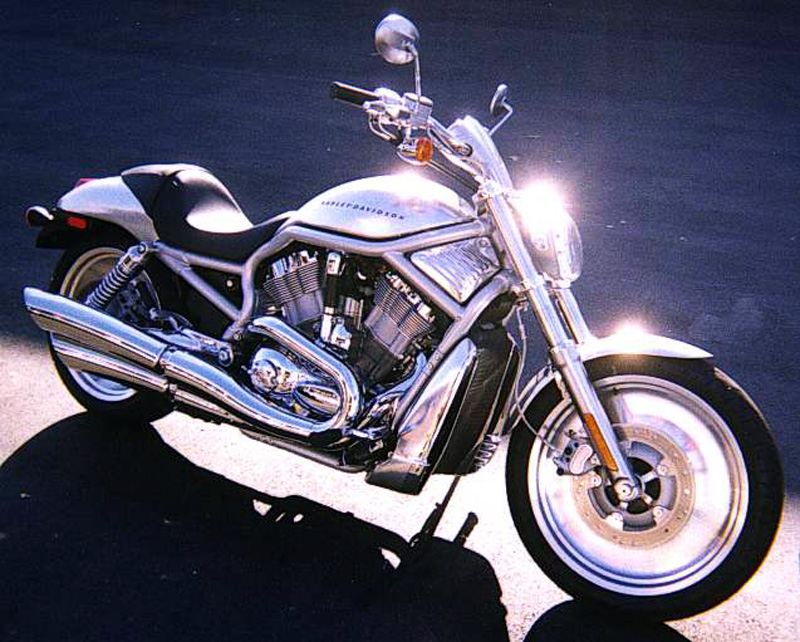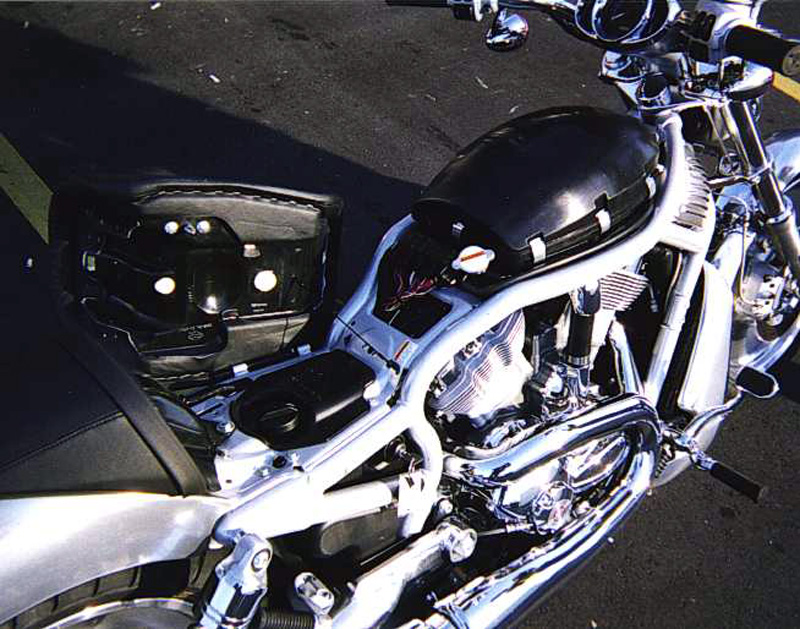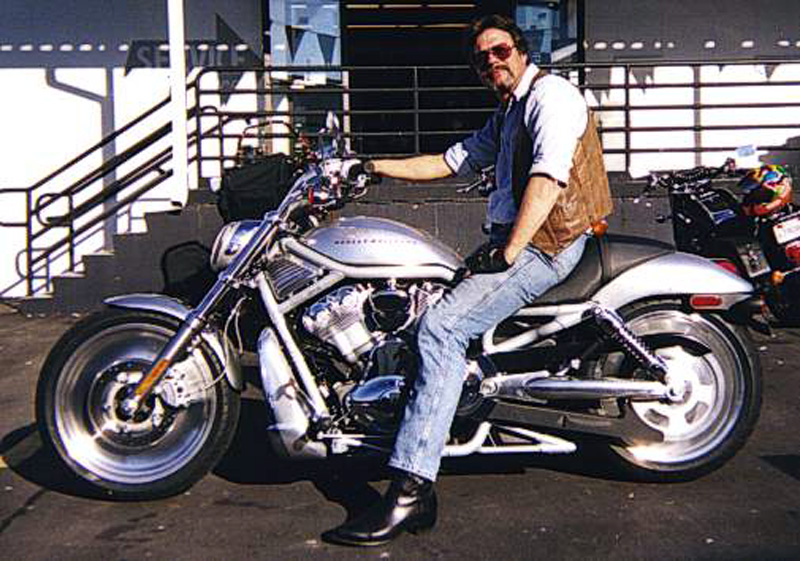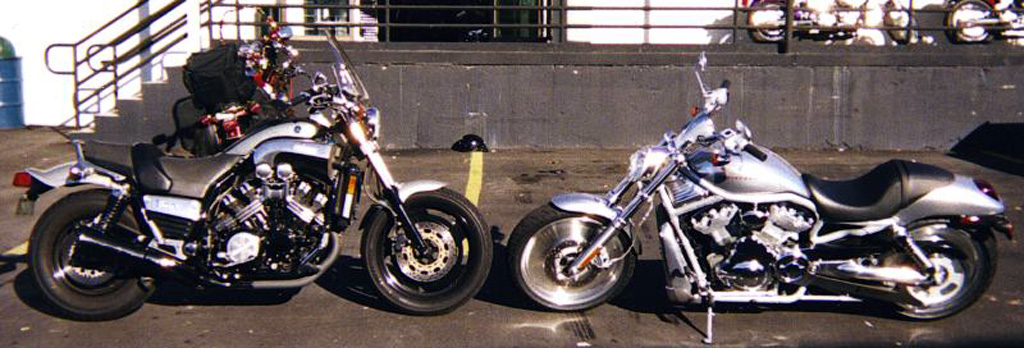2001 Harley-Davidson Revolution … VRSCA ‘V-ROD’
© Winding Roads Motorcycle Times and the author
 The current crop of Harley-Davidson motorcycles are
all powered by an engine that has its roots firmly planted in the
mid-1930s. Sure it looks and runs much
different than it’s ancestor, but essentially it is still the same 45º OHV
v-twin that powered the 1936 EL Knucklehead.
Harley-Davidson has done a magnificent job of improving and updating
that old engine to keep pace with advancing technology. The Evolution and Twin-cam engines are a
testament to the prowess of their engineers, and Corporate desire to stay true
to the expectations of the Harley faithful who want the same engine … only
better.
The current crop of Harley-Davidson motorcycles are
all powered by an engine that has its roots firmly planted in the
mid-1930s. Sure it looks and runs much
different than it’s ancestor, but essentially it is still the same 45º OHV
v-twin that powered the 1936 EL Knucklehead.
Harley-Davidson has done a magnificent job of improving and updating
that old engine to keep pace with advancing technology. The Evolution and Twin-cam engines are a
testament to the prowess of their engineers, and Corporate desire to stay true
to the expectations of the Harley faithful who want the same engine … only
better.
The world has changed significantly since 1936 and
the old must make way for the new.
Harley’s old v-twin is incapable of meeting the performance standards
that motorcyclists expect and new, more stringent emission standards that are
being levied on all gas powered, internal combustion engines. If Harley had not come up with a new engine
design for their bikes they would have been banned from much of the world by
2004, and eventually even in the US and Canada. Harley sensed this dilemma and contracted with Porsche to help in
the development of a new engine.
The VR1000 Superbike race engine provided the
cornerstone for development of the new Harley-Davidson engine, called the
“Revolution.” The Revolution engine is
still a v-twin … that’s where the similarities with the old OHV v-twin
end. The new engine is an 1130cc 60º
v-twin sporting 4 valves/cylinder, dual overhead cams, liquid cooling, and fuel
injection. It revs to 9,000 rpm and
produces 115 hp. Not bad … not bad at
all!
I had the opportunity to spend a couple hours with a
V-ROD during the Mid-Atlantic coasts unusual 70º weather in early December 2001.
The bike is technically referred to as the VRSCA by
the motor company. ‘V’ - v-twin, ‘R’ -
racing, ‘S’ - street, ‘C’ - custom and ‘A’ - the first model. It is more commonly called the V-ROD.
Visually the Vrod is stunning. My main ride is a 1997 Yamaha V-MAX so I’m
used to over-the-edge … in your face motorcycles. The V-ROD is “in your face” and most people either like it, or
they don’t. I like it.
It has some of the most outrageous engineering I
have ever seen … and it’s a Harley! The
use of light weight materials is everywhere.
The over all look is somewhat organic and yet it is obviously a
machine. I’ll bet Arnold will be riding
one in his next Terminator flick.
The engine is cradled by a modified perimeter tube
frame, but it is also framed by the frame. The frame tubes bend and arc around the engine so that it
resembles some sort of Mad Max work of art.
The faux tank and fenders are extraordinarily thin brushed aluminum. The exhaust pipes bend and arc together and
eventually curve up into an over-n-under configuration at the rear axle.

The front end has 2 rakes. The neck is 34º and the forks are kicked out 4 more degrees. This configuration gives the V-ROD a
chopperesque appearance reminiscent of the extended front ends popular in the
1960s. The headlight is recessed
between the upper fork tubes and is angled to flatter the rake of the front
end.
The controls are typical Harley and my only beef is
the turn signal switches. I prefer a
single switch on the left hand grip instead of Harleys one on each grip. At least they are self-canceling, a feature
first found on the Yamaha XS750 triple in 1976.
The instrument cluster is on the rear arcing
handlebar riser. The instruments are
clustered in an elliptical housing with the speedometer centered. On the left is the tach and on the right is
a fuel gauge. Idiot lights are
sprinkled on the face of the speedometer indicating low fuel, oil pressure,
turn signals and neutral.
Since I am a V-MAX pilot I must admit
I was eager to
give the V-ROD a good workout to see how it does. The bike I rode was slightly hopped up with the addition of
Screamin’ Eagle pipes, K&N air filter and an upgraded fuel injection
control box.
When I thumbed the starter and the engine came to life it sounded much different than the run-of-the-mill Harley. Gone was the deep “potato, potato” syncopated beat of the OHV twin. The new engine had a character and a beat of it’s own. The engine still produced a throaty, authoritative sound, but it was steadier. The only other DOHC v-twin I have ever heard was the, now extinct, Excelsior Henderson Super-X and I could not make a connection. The V-ROD sound is unique and very cool.
 The ergonomics are typical cruiser style feet forward. The bars, foot pegs and controls were no
problem for my 6’3” frame. The clutch
action doesn’t require the grip of death and the action is positive and
sure. Kicking the shifter into first
produces a light clunk with a slight lurch forward that assures a positive
shift. Releasing the clutch and giving
some throttle doesn’t produce a smooth roll off. The V-ROD is geared a little high and the bike launches forward in
fits and starts. Drive snatch is very
noticeable and doesn’t settle down until well under way. Shifting through the gears is uneventful and
a pleasant experience. The real thrill
is grabbing a handful of throttle in the V-ROD’s powerband and holding on for
dear life. This bike has excellent
acceleration all the way to it’s 9,000 rpm redline. The bike I rode had over 500 miles on it so a short visit to Mr.
Redline was not harmful. I was mindful
of standard break-in procedures so I kept the engine in it’s happy place,
mid-range, most of the time and varied the throttle.
The ergonomics are typical cruiser style feet forward. The bars, foot pegs and controls were no
problem for my 6’3” frame. The clutch
action doesn’t require the grip of death and the action is positive and
sure. Kicking the shifter into first
produces a light clunk with a slight lurch forward that assures a positive
shift. Releasing the clutch and giving
some throttle doesn’t produce a smooth roll off. The V-ROD is geared a little high and the bike launches forward in
fits and starts. Drive snatch is very
noticeable and doesn’t settle down until well under way. Shifting through the gears is uneventful and
a pleasant experience. The real thrill
is grabbing a handful of throttle in the V-ROD’s powerband and holding on for
dear life. This bike has excellent
acceleration all the way to it’s 9,000 rpm redline. The bike I rode had over 500 miles on it so a short visit to Mr.
Redline was not harmful. I was mindful
of standard break-in procedures so I kept the engine in it’s happy place,
mid-range, most of the time and varied the throttle.
As long as the bike was on the straights it felt great, light and firmly planted. In the curves the V-ROD felt skittish and unable to hold a line without moderate effort on the part of the rider.
When the time came to stop I gave the rear brake a tap. I was pleasantly surprised by an immediate reduction in speed. A slight squeeze on the front brake brought the V-ROD to a stop in no time with a minimum of effort and a great deal of confidence. I can still recall the days when bringing my old ’73 Sportster XLH to a stop was much more dicey!
Overall, I like the V-ROD. It has a lot of similarities with the V-MAX. Both share a fake fuel tank, which is actually a cover over the airbox. Both have the fuel tank under the seat. On the V-ROD the filler is accessed by turning the ignition key to the “seat” position and lifting from the right side. The passenger strap tends to cover the split between the rider and pillion seats and must be pushed to the rear.
The passenger accommodations are spartan and will probably not appeal to most back seaters. The passengers foot pegs are mounted on the swing arm and will give the pillion a good leg workout on bumpy surfaces. The rear seat itself is a small padded triangle barely large enough for a small child.
They also are fairly close in specs. The V-ROD wheelbase is longer, by 5”, and the bike is heavier, by 15 lbs, than the V-MAX.
The dyno really showed the V-RODs power. The stock V-ROD produced 98 hp. The addition of the Screamin’ Eagle pipes and the requisite changes upped that to 108 hp. Not quite up to my V-MAX’s 115 hp, but an excellent showing. The OHV engined Harleys usually put out around 65 hp in stock form.
At $16,999 MSRP the V-ROD is not the most expensive Harley, nor is it the least expensive. Harley dealers routinely price their bikes at whatever the market will bear. A dealer in New York advertised a V-ROD for $32,000, while the DC metro dealers are ~$22,000. I have read the first years production is already sold out, so price doesn’t seem to be an issue with this bike.
Whenever Harley produces something new it is big news. This is especially true in North America where the Harley-Davidson name is so revered and the mystique so ingrained. Due to poor sales Harley ceased production of the V-Rod in 2017.
